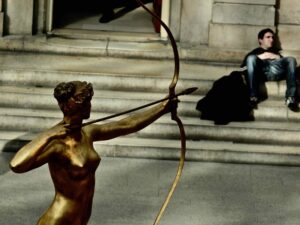
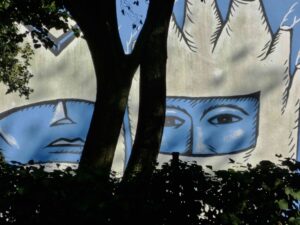
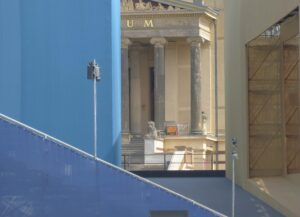
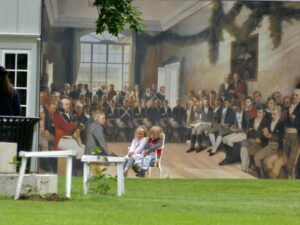
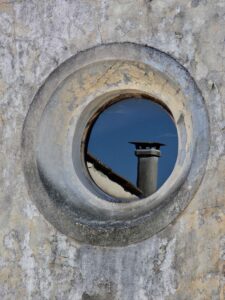

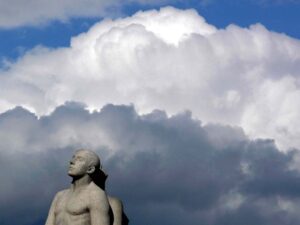

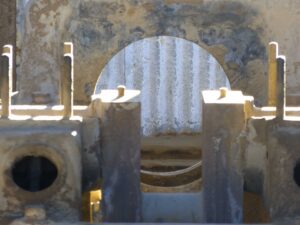
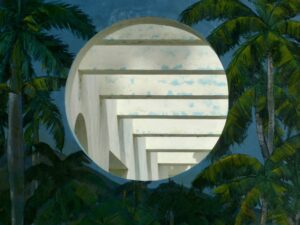
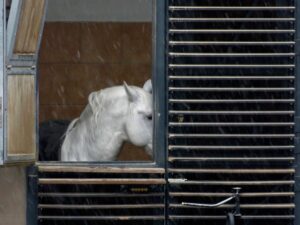
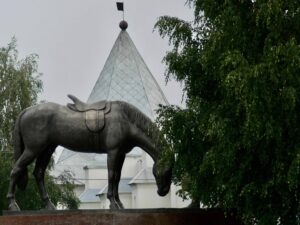
BEYOND LIGHT
Introductory essay and review by Walter Valeri
Our goal is never a place,
but rather a new way of seeing things.
Henry Miller
Visiting the photography exhibition ‘Sguardi di luce’ (Gazes of light) by en nico hosted at the Museo Internazionale della Maschera ‘Amleto and Donato Sartori in Abano Terme, near Venice, is like witnessing a dream come true, the coming into being of a myth. In one of his dreamlike and contagious bursts of good humor, Fellini claimed that “nothing exists, we imagine everything”. Perhaps this is the case, but works of the intellect, when truly such, are always endowed with material thickness as well; that excess which, at first sight, might seem surreal then turns out to belong to reality, as it exceeds its boundaries. In reviewing en nico’s photographs, objects and images are often brought together in shapes and sizes that are juxtaposed, which results in the viewer realizing that the photos come alive by a sort of infection with their opposites. The bodies described fall apart while retaining their concrete permanence. In other words: they allude to something else like any true work of art should do. They reaffirm that every form produced by an artist certainly lives by its own internal rules, but is structured and exists also thanks to those who view it. Art is organized through our language with the original freshness of our discovery, as it surprises us for its extreme sophistication. These photos are bright forays into the visible, they are capable of eliciting interpretations, thoughts, ideas and symbols which in turn invite new suggestions. All this thanks to the camera. Thus, as you walk among ancient statues, squares and streets, natural landscapes and museums, it might happen that the words uttered by artist, poet and Fellini collaborator Tonino Guerra suddenly resurface, mischievously reminding us that ‘you never know.’ We don’t really know who is looking at us. Though, taking to heart Dante’s entire body of work, we should remember “The only truth that is possible is the one we implant and make grow in the minds of others”. This is the ‘agony and ecstasy’ that governs human beings; and that barely allows us to distinguish between what is visible from what is not.
Besides being ‘beautiful’ and ‘pleasant’, in the sense of surprising, en nico‘s shots coincide with a photographic event capable of implanting and raising in the minds of the viewers the insights of an active, unique and ironic imagination. His is certainly a gallery of his own subjective memory, but also a creation common to the minds of others, which is permanently renewed, thanks to glimpses patiently collected during his countless journeys; wonders that resist oblivion. These shots are able to lend a compact form to the infinite impulses of the visible. They are therapeutic aesthetic forms that establish a dialogue with the viewer, with their talent and critical thinking. A luminous and ‘disruptive’ gateway capable of redefining the nature of the present. One of his possible choices, as well as escape routes.
Through his lens, en nico captures both the comic and tragic aspects of life by deploying his primal humor, associated with the five senses. Life flowing with humor as it looks at itself; while the photographer, with a steady and admiring eye, lends it a fixed shape in a shot. A gaze that is fully aware that the comic always contains something tragic, and vice versa. As occurs in certain shots by Man Ray, crossed by a fervent red thread of intuitive and lucid ingenuity, capable of transforming, transfiguring, reinventing each subject with poetic grace.
The photographer, who has been using the en nico pseudonym for years, shows extraordinary sensitivity and imaginative sensuality, that is not hardened by an excess of consciousness, “Unconcerned, but not indifferent”, the motto engraved on the gravestone of the genius of 20th century photography, Man Ray. They are colorful shots that capture the brief moment of the present, that fleeting moment that shall never be repeated, that can never return. As if it were the eye of a mother caressing her just born baby, for the first time, and yet she already entrusts it to the past. More than an complete human being, the baby is a being who does not wish to leave behind the mystery of life; which only a few moments before existed only in the imagination of the parents responsible for generating it. In this Fellini was absolutely right. There are many images that testify to this. For example: the beautiful and terrible photograph of the wall undermined by a crack, which appears to be supporting the roof, to whose tragic fate it alludes, a metaphor taken in Vilnius (Lithuania) in 2007. Pain approached with caution by the photographer, who is like a hunter stepping softly, eager to put the ‘evil of living’ into his hunter ‘s bag.
We can thank the photographer for his concern and attention in educating our sight as viewers, a sense grown lazy from too many self-blindings and placebos. There is a certain fierceness in these visual jokes he plays on the volunteering blind; meant for friends near and far, as well as those who live next door to him. According to Vasari, Leonardo da Vinci who often loved to joke and, be, in his own way, fierce, would walk down the street with a lizard on his shoulders (to which he had affixed wings, horns and a crest) and would amuse himself playing tricks on passers-by, telling them it was a little dragon.
Well, en nico‘s photographic work could be compared to Leonardo’s little paper dragon: both an ironic and expressive art engine, made of lightness and walnut shells, useful for floating and breaking. In these days, it may also be useful also for blowing up the electronic rags that the mass cultural industry has been remotely deploying for months to blunt our consciousness. These visual tricks can make us ponder how, with the excuse of saving ourselves, we are all witnessing the catastrophic victory of Power that uses mass surrealism for the sadistic count of the dead while the rest of us infected wait for a new Renaissance.























































